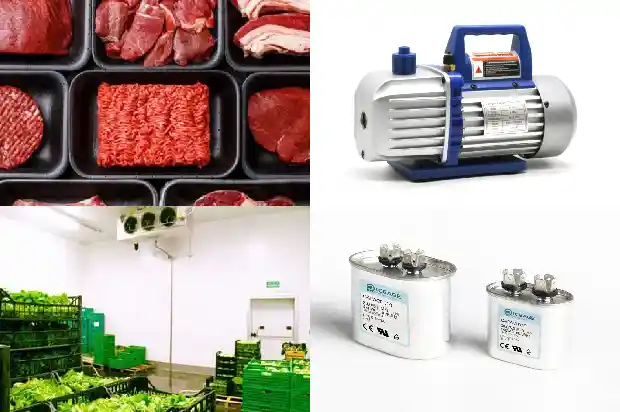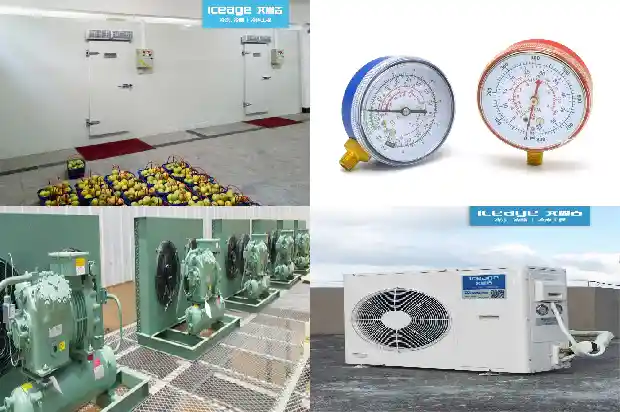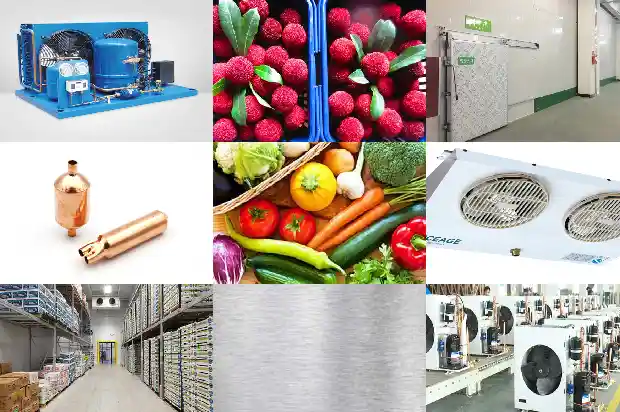Five Common Problems in the Refrigeration System~~ Solve Them One by One!
2025-03-02
I.

- Fault Phenomenon:
The overall refrigeration effect of the unit is poor. The water outlet is only slightly cool. When checked with a manifold pressure gauge, it is found that the pressures on both the high-pressure side and the low-pressure side are low (at the normal rotation speed of the compressor, when the ambient temperature is around 35°C, the reading of the low-pressure gauge is lower than 1 kg/cm², and the reading of the high-pressure gauge is lower than 10 kg/cm²). Meanwhile, bubbles can be seen flowing in the sight glass. - Fault Cause:
There is a refrigerant leakage point in the refrigeration system, resulting in insufficient refrigerant. - Handling Method:
- Use an electronic leak detector to find the leakage point and repair or replace the component.
- If no components are replaced, simply replenish an appropriate amount of refrigerant; if components are replaced, add an appropriate amount of refrigeration oil as required, evacuate the system, and then add enough refrigerant.
II. Excessive Refrigerant Charging
- Fault Phenomenon:
The refrigeration effect is poor. When checked with a manifold pressure gauge, it is found that the pressures on both the high-pressure side and the low-pressure side are too high (when the compressor rotation speed is normal and the ambient temperature is 35°C, the pressure of the high-pressure gauge is about 19 kg/cm², the pressure of the low-pressure gauge is 2.3 kg/cm², and no bubbles can be seen flowing in the sight glass. - Fault Cause:
Too much refrigerant is charged into the refrigeration system, preventing the full utilization of the refrigeration capacity and resulting in a poor refrigeration effect. - Handling Method:
Connect a manifold pressure gauge to the system, slowly loosen the low-pressure side manual valve of the manifold pressure gauge, and let the refrigerant be discharged slowly (do not discharge from the high-pressure side because discharging refrigerant from the high-pressure side will carry out a large amount of refrigeration oil) until the pressures on the high and low sides are normal. Meanwhile, the refrigerant can be seen flowing clearly in the sight glass, and occasionally bubbles flow through.
III. Air Mixed into the Refrigeration System
- Fault Phenomenon:
The overall refrigeration capacity of the unit decreases. When checked with a manifold pressure gauge, it is found that the pressure on the high-pressure side is higher than normal, and the pressure on the low-pressure side is sometimes also higher than the normal value (when the compressor rotation speed is normal and the ambient temperature is 35°C, the pressure on the high-pressure side is higher than 20 kg/cm²; and the pointer of the high-pressure gauge swings. On the other hand, many bubbles can be seen flowing in the sight glass. - Fault Cause:
Air is mixed into the system. Mainly, after assembly or major repair, the evacuation is not thorough; when charging refrigerant or adding refrigeration oil, air is brought into the system, or when the system operates under negative pressure, air is mixed in through the untight parts. After air enters the refrigerant, it has a certain pressure, and the refrigerant also has a certain pressure. In a closed container, the total pressure of the gas is equal to the sum of the partial pressures, so the readings of both the high and low-pressure gauges are higher than the normal values. - Handling Method:
- Release the refrigerant (slowly release it from the low-pressure side with a pressure gauge).
- Check the cleanliness of the compressor oil.
- Evacuate and recharge the refrigerant.
IV. "Ice Blockage" in the Refrigeration System
- Fault Phenomenon:
The refrigeration system periodically cools and then stops cooling. During the operation process, the pointer of the low-pressure side on the manifold pressure gauge often fluctuates between negative pressure and the normal value. - Fault Cause:
Moisture is mixed into the refrigerant in the refrigeration system. Since moisture is immiscible with the refrigerant, when the refrigerant flows through the throttling orifice of the expansion valve, the temperature drops suddenly. The moisture mixed in the refrigerant is likely to form small ice particles in the shape of spheres or hemispheres around the throttling valve orifice or the valve needle hole. When the ice particles accumulate to a certain extent, they block the throttling passage, causing an ice blockage fault. After ice blockage occurs due to ice formation, the refrigeration system cannot work normally, the refrigeration effect decreases significantly, or it even stops cooling.
At this time, the low-pressure gauge shows a negative pressure, so the temperature at the ice blockage point rises significantly, and the ice particles of the ice blockage melt into water, making the ice blockage phenomenon disappear. The refrigeration system resumes normal operation with good refrigeration, and the pressure on the low-pressure side returns to normal.
After a while, the ice blockage occurs again in the system, and the system does not work properly.
- Handling Method:
- Since the desiccant is in a supersaturated state, the receiver with the desiccant must be replaced, and 30 ml of refrigeration oil should be added.
- Evacuate the system and add the specified amount of refrigerant.
V.

- Fault Phenomenon:
The refrigeration effect is poor or there is no refrigeration. When the air conditioning system is running, the readings of both the high/low-pressure gauges on the manifold pressure gauge are lower than the normal values (when the compressor rotation speed is normal and the ambient temperature is around 35°C, the pressure on the high-pressure gauge side is lower than 9 kg/cm², and the pressure on the low-pressure side is in a negative pressure state), and there is frosting or condensation on the pipelines before and after the filter and the capillary tube. - Fault Cause:
Dust in the refrigeration system adheres or attaches to the filter screen at the inlet end of the filter, or at the interface between the capillary tube and the filter screen, resulting in a local throttling phenomenon at this position. The temperature drops rapidly, causing condensation or frosting. - Handling Method:
- If there is a frosting phenomenon at the inlet of the filter and an intermittent airflow sound can be heard, gently tap the filter body with a small wrench. If the airflow sound changes and the frost layer in front of the filter and the capillary tube melts at the same time, it can be judged that the filter screen at the inlet of the filter is blocked.
At this time, it should be:
① Remove the capillary tube, clean the filter screen and blow it dry, and reinstall it. Or replace the filter.
② Evacuate and charge the refrigerant to the specified amount.
Related Articles
- Have You Encountered the Three Common Problems of Refrigeration Compressors?
- Pipelines Used in the Refrigeration System
- Does a lower evaporation temperature result in a larger refrigeration capacity, or does a higher evaporation temperature lead to a larger refrigeration capacity?
- Energy - saving Control and Adjustment of Main Operating Parameters of the Refrigeration System
- HVAC - Concise Explanation of Refrigeration Principles
- Analysis of Common Auxiliary Components in the Refrigeration System One by One
- A Detailed Analysis of the Nine Reasons for the Low Pressure in the Refrigeration System!
- These Inspections before Starting the Refrigeration Unit Are Very Important~~
- Common Fault Causes of Totally Enclosed Refrigeration Compressors
- Popularize Refrigeration Knowledge You've Never Noticed, Which Is Actually Very Crucial
- Analysis of Common Auxiliary Components in the Refrigeration System
- Does the Refrigeration System Definitely Need to Be Evacuated? What Will Happen If It Isn't?
- Common Faults in Refrigeration Systems and Handling Methods
- Why Should Refrigeration Shut - off Valves Have "Low - Inlet and High - Outlet" Design?
- Four Requirements for Refrigeration Systems Adopting Two - stage Compression Refrigeration Systems
- Screw Compressor Units: Principles, Design and Selection - Essential Guide for Refrigeration Beginners
- Don't Overlook: The Impact of Capillary Tube Length on Refrigeration System Parameters
- Refrigeration Repair Techniques: A Must - Know - "Sub - cooling" and "Super - heating"
